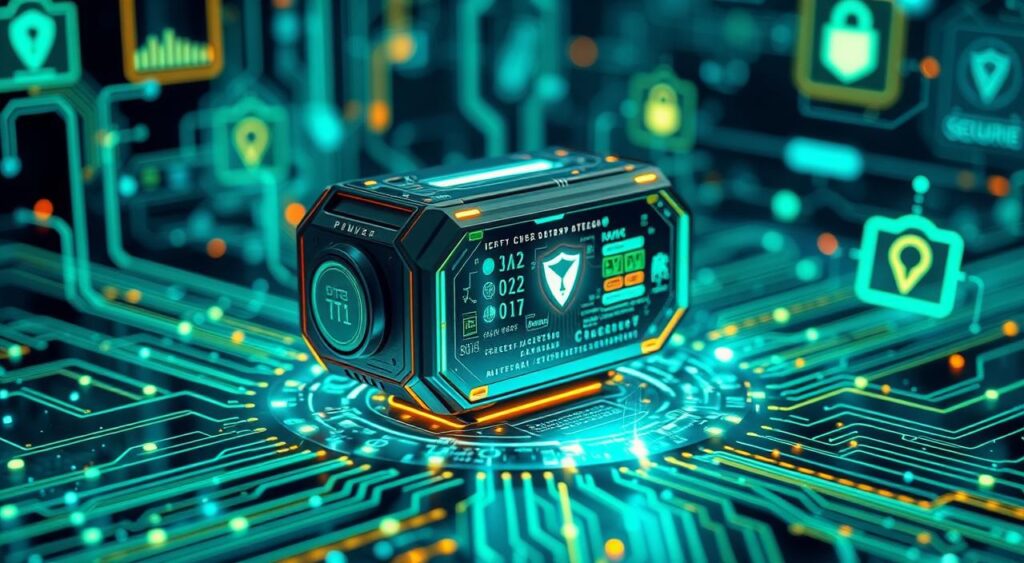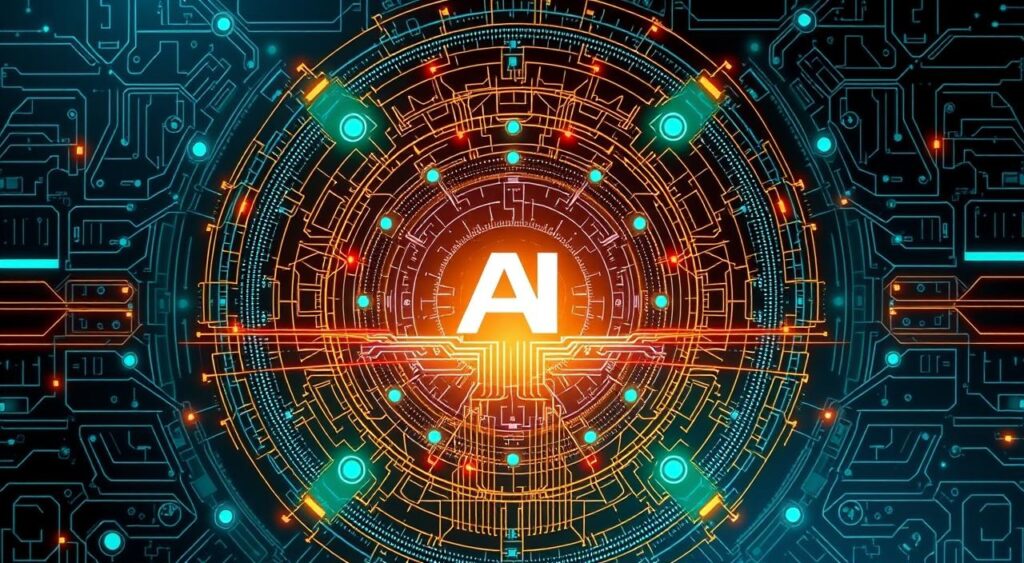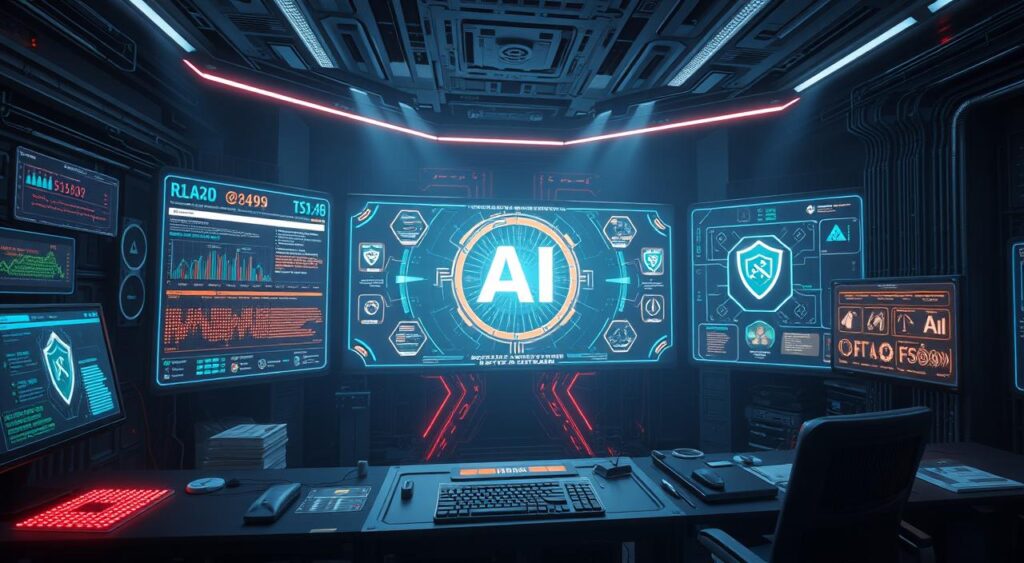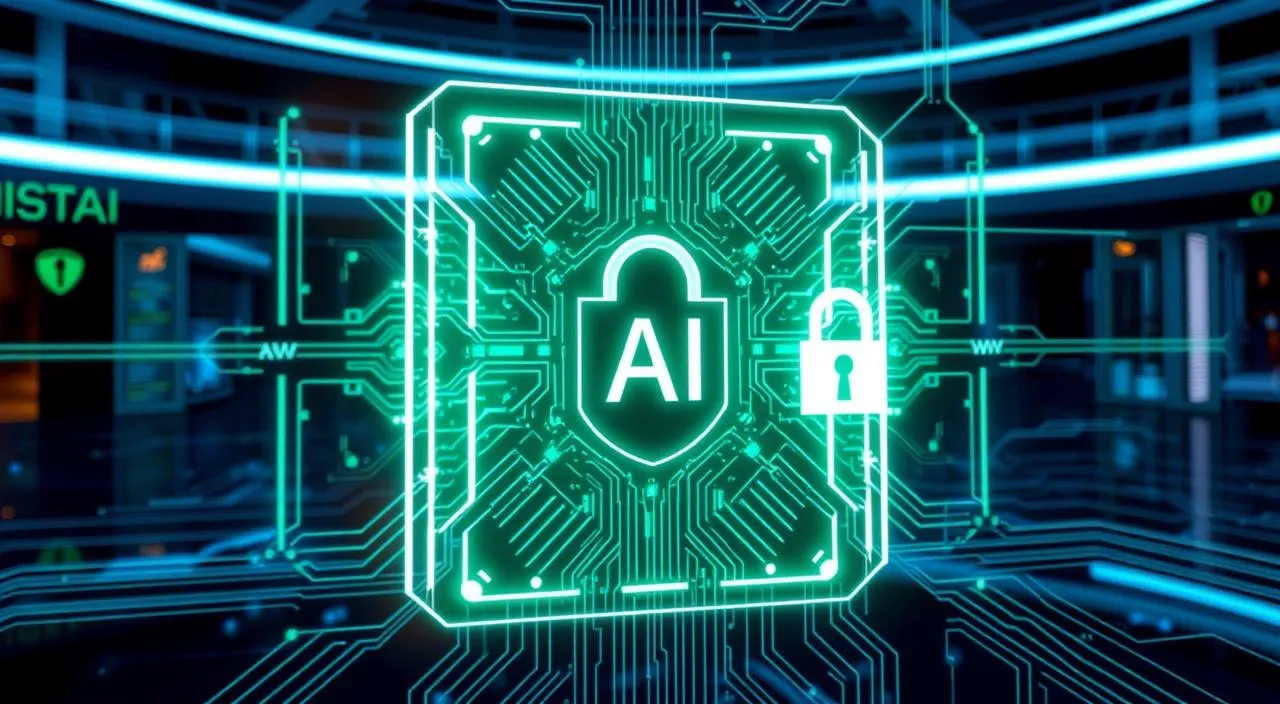Many secondary teachers have seen students submit work not their own. This shows how common cheating is in schools. To fight this, there’s a big need for tools that can spot and stop cheating. AI detection software is key in keeping digital stuff safe and private, especially in schools.
AI threats are growing, so we need strong AI detectors to fight them. These tools say they can tell how much of a text is AI-made. They look at word choices, sentence shapes, and how complex the text is. This tech is vital today, where keeping our digital stuff safe is more critical than ever.
Understanding the value of ai detector solutions is crucial.
Key Takeaways
- AI detectors are essential in safeguarding digital assets and privacy.
- AI detection software can detect and prevent AI-powered threats, such as deepfakes and phishing attacks.
- AI detection claim to determine the percentage of writing generated by AI, emphasizing a reliance on statistical patterns in word choice, sentence structure, and complexity.
- There has been a significant rise in the number of AI-generated content detection tools due to the accessibility of generative AI technologies.
- AI detection analyze linguistic features such as vocabulary, clichés, idioms, colloquialisms, coherence, and flow, relying on large datasets of both human-written and AI-generated text.
Understanding AI Detection Technology
Exploring AI detection means learning about its core parts. These systems use machine learning and ai sensor tech to spot threats. They’ve become smarter, helping to stop AI threats.
The success of AI detectors depends on their training data. Better data means they can catch more writing styles. Some can hit up to 90% accuracy in tests. But, they need to work fast and accurately with more content coming in.
AI tools work well with word and sentence analysis. But, they’re not always right on sensitive topics. As AI text makers get better, AI detection might miss more.
To beat these hurdles, we need better AI detectors. Using ai sensor tech and tools, we can guard our digital world.
The Growing Need for AI Detection in Today’s Digital World
As AI technology gets better, more AI threats appear. This means we need smarter AI detection to stop these threats. Advanced AI detection systems are now being made to spot and stop AI-made content. With more AI threats, it’s crucial to have a system that can automatically detect them.
AI detection systems can handle lots of data, work in many languages, and give detailed reports. These are key for companies fighting AI threats. Tools like Grammarly can also check text against many examples to see if it’s AI-made.
Here are some benefits of using an advanced AI detection system:
- Improved security measures
- Enhanced detection capabilities
- Automated threat response
These benefits show why companies should invest in AI detection systems to safeguard their digital assets.
In conclusion, the need for AI detection is growing because of more AI threats. Advanced and automatic AI detection systems are key for companies to fight these threats. By using these systems, companies can boost their security, improve detection, and automate response.
| Feature | Description |
|---|---|
| Advanced AI detection | Ability to detect and mitigate AI-generated content |
| Automatic ai detection system | Ability to automatically detect and respond to AI-powered threats |
| Multi-language support | Ability to support multiple languages and detect AI-generated content in different languages |
How AI Detectors Protect Your Digital Assets
Protecting your digital assets is key in today’s digital world. An ai detection tool can spot threats and act fast. It uses a machine learning algorithm to find and mark suspicious activity, keeping your digital stuff safe.
Ai detectors watch systems live, ready to tackle threats fast. They use advanced algorithms to catch and alert you to suspicious actions. Using an ai detection tool brings many benefits, including:
- Stronger security for your digital assets
- Live monitoring to spot threats quickly
- Quick action plans for suspicious activity
With a machine learning algorithm and automated systems, your digital assets are safe from threats. As more people need reliable content detectors, using an ai tool is vital. It helps keep your digital assets safe and your online presence secure.
Key Features of Modern AI Detector Solutions
Modern AI detector solutions have key features that help fight AI threats. They use smart detection systems, ai anomaly detection, and ai-powered detectors. Studies show AI detection can spot deepfake videos with over 65% accuracy. They also help in healthcare by analyzing images to find diseases accurately.
Using these solutions brings many benefits. For example:
- They add strong security with smart detection systems
- They watch for AI threats in real-time with ai anomaly detection
- They boost accuracy and speed in stopping threats with ai-powered detectors
AI detection also cut down on false alarms by 75% in finance. Social media has seen a 60% drop in fake news thanks to AI.

In summary, modern AI detection solutions have many features and benefits. They help protect against AI threats. By using smart detection, ai anomaly detection, and ai-powered detectors, organizations can strengthen their security.
Types of Threats an AI Detector Can Identify
AI detectors can spot many threats, like AI-made content, deepfakes, and bots. They use smart tech and deep learning to do this. They check how files act to find new malware. AI-powered tools can find threats 30% faster than old methods.
Here are some threats AI detectors can find:
- AI-generated content detection, which spots content made by AI
- Deepfake recognition, which finds deepfakes
- Automated bot detection, which spots bots
AI in access control cuts down unauthorized access by over 75%. It looks at how users act. This way, it catches 92% of attacks, both known and unknown.
AI detection also watch network traffic live to catch unauthorized access. Machine learning fights zero-day exploits in 70% of cases. AI can spot 90% of threats quicker than old ways.
| Threat Type | Detection Rate |
|---|---|
| AI-generated content | up to 95% |
| Deepfakes | up to 95% |
| Automated bots | up to 90% |
Implementing AI Detection in Your Security Framework
To keep your digital assets safe, you need to add AI detection to your security plan. This means using AI detectors with your current security systems. This extra layer helps fight AI threats. Recent data shows that companies face many security issues, like cybercrimes and data breaches.
Advanced digital risk protection is key because threats keep changing. This makes it important to have security that can adapt.
AI detection software is vital in stopping fraud. It shows that fraud and fake news can harm a company’s money and reputation. AI can spot and stop threats like fake videos and bots. Using AI tools helps keep your digital world safe.
Some main benefits of using AI detection include:
- Stronger security
- Constant monitoring
- Quick response to threats
These advantages come from using top-notch AI detection tools. They can spot and handle threats right away. Also, AI can stop fraud and fake news, which can hurt a company’s finances and image.

In short, adding AI detection to your security plan is crucial for digital safety. By using AI tools, you can boost your security and protect against many threats. It’s vital to keep up with new threats and update your security often for the best protection.
Benefits of Using an Advanced AI Detection System
An advanced ai detector offers many advantages, like better security and saving money. It can quickly scan through lots of data to spot threats, helping security teams act fast. This is especially helpful in places like hospitals, where old metal detectors need many people to work, making things more expensive.
Also, an advanced AI system can save money. It lets machines do the screening, so people don’t have to watch all the time, cutting down on costs. Plus, AI can cut down on identity fraud by up to 30% by checking identities better. Some main benefits of using an advanced AI detection system are:
- It finds threats quickly, making security better
- It saves money by not needing as many people
- It can respond to threats fast, making security actions quicker
In summary, an advanced AI detection system brings many benefits. It makes security better and saves money. By using AI technology, companies can get stronger security and spend less. Also, AI can solve complex problems fast, much quicker than humans.
Common Challenges in AI Detection and Solutions
When you set up an intelligent detection system to protect your digital stuff, you might face some hurdles. One big worry is that AI threats can be tricky to catch by automated systems. To beat this, it’s key to keep your machine learning algorithm sharp to spot and stop new AI threats.
Another challenge is that AI detection tools can sometimes make mistakes, wrongly accusing people. Also, not having clear rules for AI use in school can lead to cheating. To fix this, it’s important to set clear AI use rules and use research-backed ways to make assignments. This helps keep students engaged and less tempted to cheat with AI tools.
Some common challenges in AI detection include:
- Complexity of AI-powered threats
- High error rates of AI detection software
- Lack of clear guidelines on AI use in courses
To tackle these issues, you need a strong AI detection system. It should use a machine learning algorithm to catch and stop AI threats. Also, having clear AI use rules and using research-backed assignment methods can help avoid AI misuse problems.

By tackling these challenges and using effective solutions, you can keep your digital stuff safe and stop AI threats. An automated detector system can spot and block AI threats. Meanwhile, a machine learning algorithm keeps improving the detection system.
| Challenge | Solution |
|---|---|
| Complexity of AI-powered threats | Implement a robust intelligent detection system |
| High error rates of AI detection software | Continuously update the machine learning algorithm |
| Lack of clear guidelines on AI use in courses | Establish clear guidelines on AI use and implement research-backed assignment strategies |
Best Practices for AI Detector Configuration
Configuring an AI detector right is key for top performance. Use an ai analysis tool to check settings and an ai sensor technology to watch its work. These tools help make your AI detection better and more accurate.
When setting up an AI detection, think about a few things. Look at the advanced ai detection algorithm, sensitivity level, and file types. For example, some detectors have a 15,000 character limit for documents. Others work with WhatsApp and Telegram, making it easy to use.
Initial Setup Guidelines
Here’s how to start with your AI detector:
* Use a simple API to get to tools like the AI Detection and Plagiarism Checker
* Make sure the detector works with many languages, keeping accuracy high for each one
* Set it to make .pdf reports for each detection, proving work is AI-free
Optimization Strategies
To make your AI detector better, try these tips:
* Use a multi-step method to boost accuracy and cut down on mistakes
* Train the AI on lots of internet and school data, plus special AI-made datasets
* Keep updating the detector to catch new AI threats
Integration With Existing Security Systems
Integrating ai detection software with your current security systems is key. It boosts your defense against AI threats. A machine learning detector can spot vulnerabilities and monitor in real-time. This lets you act fast to threats.
Some important things to think about when integrating include:
- Compatibility with existing security systems
- Scalability to meet growing security needs
- Ease of configuration and maintenance
Millions of users rely on ai detection software, showing its trustworthiness. DeepAnalyse™ Technology uses many data sources, including AI datasets. This means it’s trained on a wide range of data for better accuracy.
By adding ai detection software to your security, you get a strong defense against AI threats. This mix supports detection in all languages, showing high accuracy.

Machine Learning Algorithms in AI Detection
Machine learning algorithms are key in AI detection. They help create smart systems that spot and stop AI threats. These algorithms use patterns, behavior analysis, and predictive models to find and block AI dangers.
Using machine learning in AI detection is vital. It helps stop plagiarism in school and publishing, keeping work original. It also keeps trust and honesty, important for brands and institutions.
Some main techniques in machine learning for AI detection are:
- Pattern recognition systems: These spot AI patterns in data.
- Behavioral analysis methods: These look at user actions to find AI signs.
- Predictive modeling techniques: These guess AI content chances based on past data.
These methods help smart systems find and stop AI threats. This keeps digital content real and trustworthy.
| Technique | Description |
|---|---|
| Pattern recognition systems | Identify patterns in data indicative of AI-generated content |
| Behavioral analysis methods | Analyze user behavior to detect anomalies indicative of AI-generated content |
| Predictive modeling techniques | Predict likelihood of AI-generated content based on historical data and patterns |
Privacy Considerations When Using AI Detectors
Using AI detectors raises important privacy questions. A Pew Research Center study found that 79% of Americans worry about their data use by companies. This worry is real because AI detection use smart tech and deep learning to work. To address these worries, it’s key to design AI detection with privacy in mind, using data minimization and anonymization.
Some important privacy points for AI detectors include:
- Being clear about data collection and use
- Offering users the chance to opt out
- Doing regular checks to follow rules
AI detection can also work with other security tools, like facial recognition. For example, AI image detection is used in airports to check passengers’ identities. But, it’s vital to make sure these systems protect personal data well.
It’s also worth noting that AI detectors can be biased and not always accurate. They can spot AI-generated text about 28% of the time. So, it’s crucial to check how well and fairly AI detection work before using them. This helps avoid privacy and security issues.
In the end, using AI detectors needs a careful balance. We must weigh the security benefits against privacy risks. By focusing on transparency, getting user consent, and following rules, we can use AI detection safely and protect privacy.
Measuring the Effectiveness of Your AI Detector
To make sure your AI detection works well, you need to check its performance. Look at how well it spots AI-generated content, which can be up to 99.98% accurate with tools like Winston AI. Also, see how many threats it finds and how fast it acts on them.
Some important metrics to watch include:
- Detection accuracy rate
- Response time to potential threats
- Number of false positives and false negatives
These numbers help you see how good your AI detection is and where it can get better. For example, if it’s very accurate but slow, you might need to tweak its settings or get a better tool.
Also, think about how many threats it stops and how safe your digital stuff is. By checking these things often, you can keep your AI detector working well. This means your digital stuff stays safe, thanks to automated ai analysis and machine learning detector.
By looking at both performance and success, you get a full picture of your AI detector’s success. This lets you make smart choices to make it better, using ai detection software. This way, you can stay one step ahead of threats and keep your digital stuff safe.
| Performance Metric | Description |
|---|---|
| Detection Accuracy Rate | The percentage of correctly identified AI-generated content |
| Response Time | The time it takes for the AI detection to respond to a potential threat |
| False Positives and False Negatives | The number of incorrectly identified human-generated content and missed AI-generated content |
Future Developments in AI Detection Technology
AI detector technology is getting better, with more advanced machine learning and integration with other security systems. This means we’ll have better protection against AI threats like deepfakes and bots. Artificial intelligence detector tools will also become more common, helping to spot and flag suspicious content.
The future of AI detection is linked to better machine learning, especially in natural language processing. As these models get smarter, we’ll see more accurate AI detection. They’ll be able to tell the difference between content made by humans and machines. This is key in fields like education and content creation, where originality matters a lot.
Some major advancements in AI detection include:
- More accurate machine learning algorithms
- Integration with other security systems for better protection
- More use of AI detection tools in different industries
As generative AI tools become more popular, we’ll need better AI detection technology. By keeping up with advancements and investing in better AI detection, we can protect digital content’s integrity and authenticity.
Selecting the Right AI Detector for Your Needs
Choosing the right AI detector is key. Look for a machine learning algorithm to help it learn and get better over time. It should spot threats and give you accurate results, avoiding false alarms.
Think about what you need and what each tool offers. Check the accuracy, the threats it can find, and how easy it is to use. Also, make sure it keeps up with updates and values your security and privacy.
Here are some important things to remember when picking an AI detection:
- Assessment criteria: Check the tool’s accuracy, features, and capabilities
- Comparison factors: Look at different tools and their features to find the best one for you
- Decision framework: Have a clear plan to choose the right tool
By carefully looking at your needs and these factors, you can pick an AI detection that protects you well. With the right tool, you’ll get the most out of machine learning, automated detection, and smart systems.
Conclusion
The digital world is changing fast, making strong AI detection more important than ever. These tools protect your online stuff and keep your privacy safe. They spot AI-made content, deepfakes, and bots very well.
AI detectors use smart machine learning and predictive models. This helps you keep up with the digital world and control your online image.
The future of AI detection looks bright, with better integration into security systems. As AI gets smarter, AI detection will play a bigger role. This means you can explore the digital world safely and without worry.
If you’re a business owner, content creator, or just want to keep your online identity safe, get a good AI detection. Being informed and proactive lets you use AI to its fullest. It also keeps your digital stuff and privacy safe. Use AI detectors to take charge of your digital life.
FAQ
What is an AI detector?
An AI detection is a tool that finds and stops AI threats like deepfakes and phishing.
What are the core components of AI detection systems?
AI detection systems use machine learning, sensors, and advanced analytics.
Why is there a growing need for AI detection?
More AI threats are coming as AI tech gets better.
How do AI detection protect digital assets?
They spot threats, watch systems live, and act fast to protect digital stuff.
What are the key features of modern AI detection solutions?
Modern solutions include smart detection, AI anomaly spotting, and AI-powered tools.
What types of threats can an AI detector identify?
They can find AI-made content, deepfakes, and bots.
Why is it essential to implement AI detection in a security framework?
It adds a layer of defense against AI threats.
What are the benefits of using an advanced AI detection system?
It boosts security, saves money, and responds to threats automatically.
What are the common challenges in AI detection?
It’s hard because AI threats are complex and new ones keep coming.
What are the best practices for AI detection configuration?
Start with setup tips, then optimize and keep it up to date.
How can AI detectors be integrated with existing security systems?
They can add extra protection to your current security setup.
What role do machine learning algorithms play in AI detection?
They’re key for spotting and stopping AI threats through patterns and analysis.
What privacy considerations are important when using AI detection?
They must protect your data and keep it private.
How can the effectiveness of AI detectors be measured?
Check their performance, success, and ROI to see if they work well.
What future developments can we expect in AI detection technology?
Expect better algorithms and more integration with other security systems.
How can you select the right AI detection for your needs?
Look at what they offer, compare, and use a framework to choose the best one for you.

